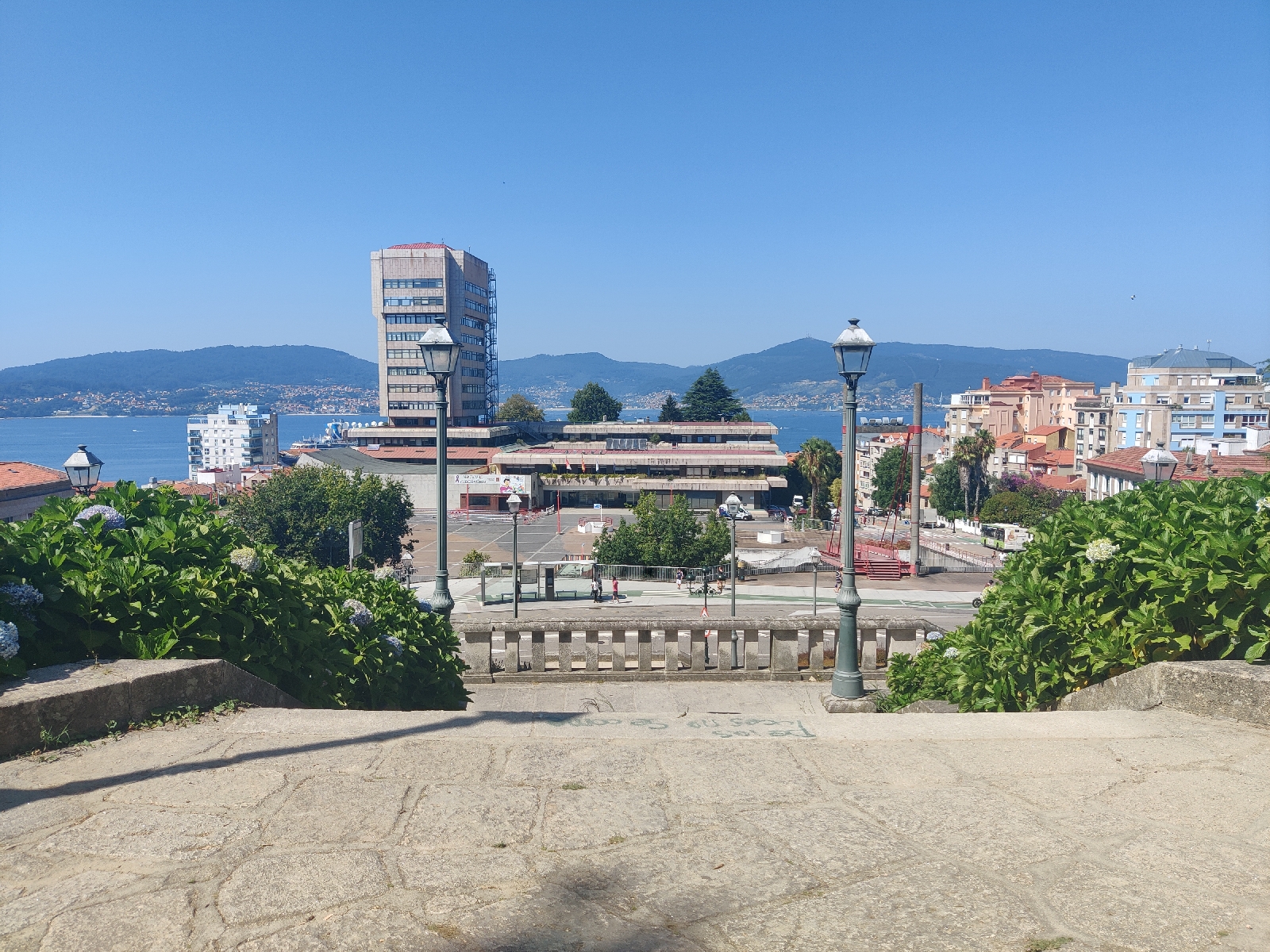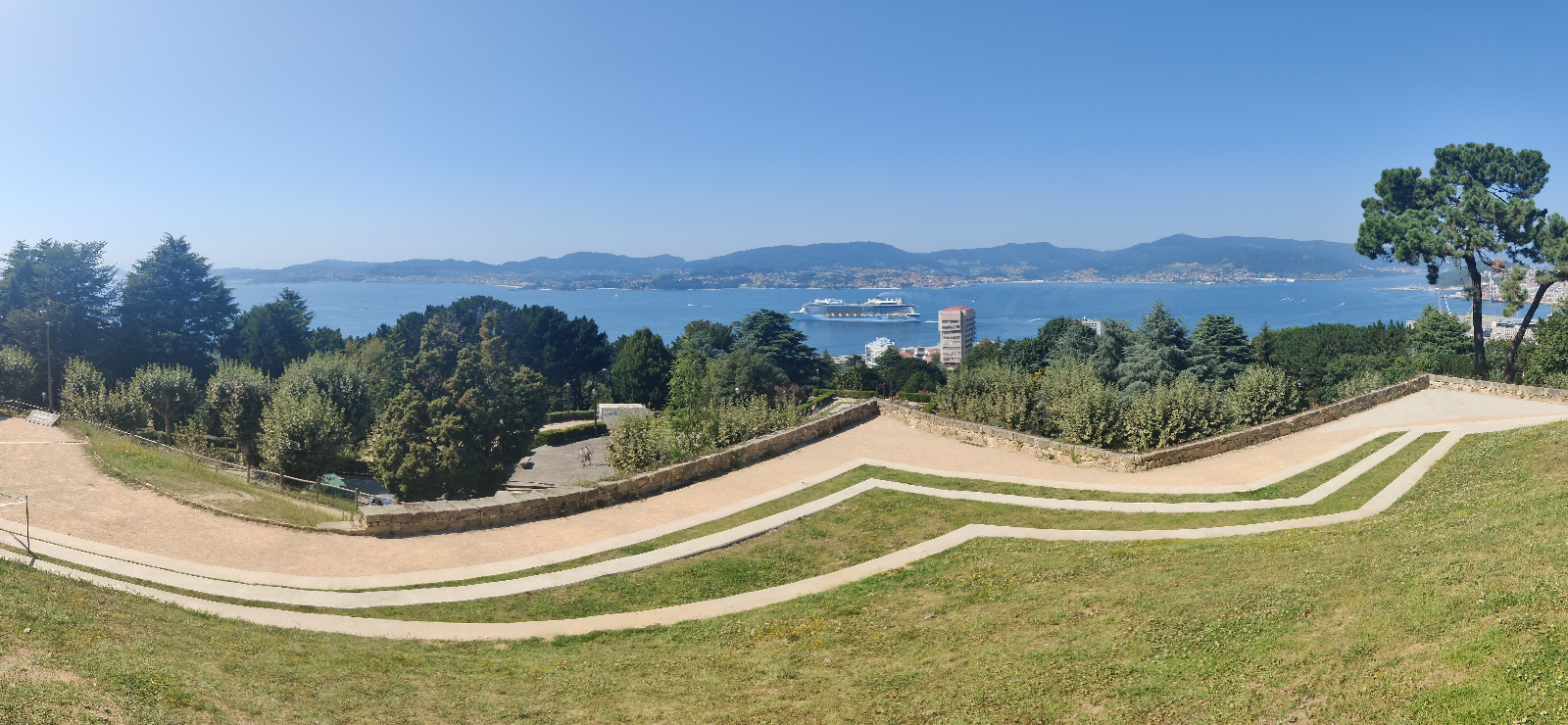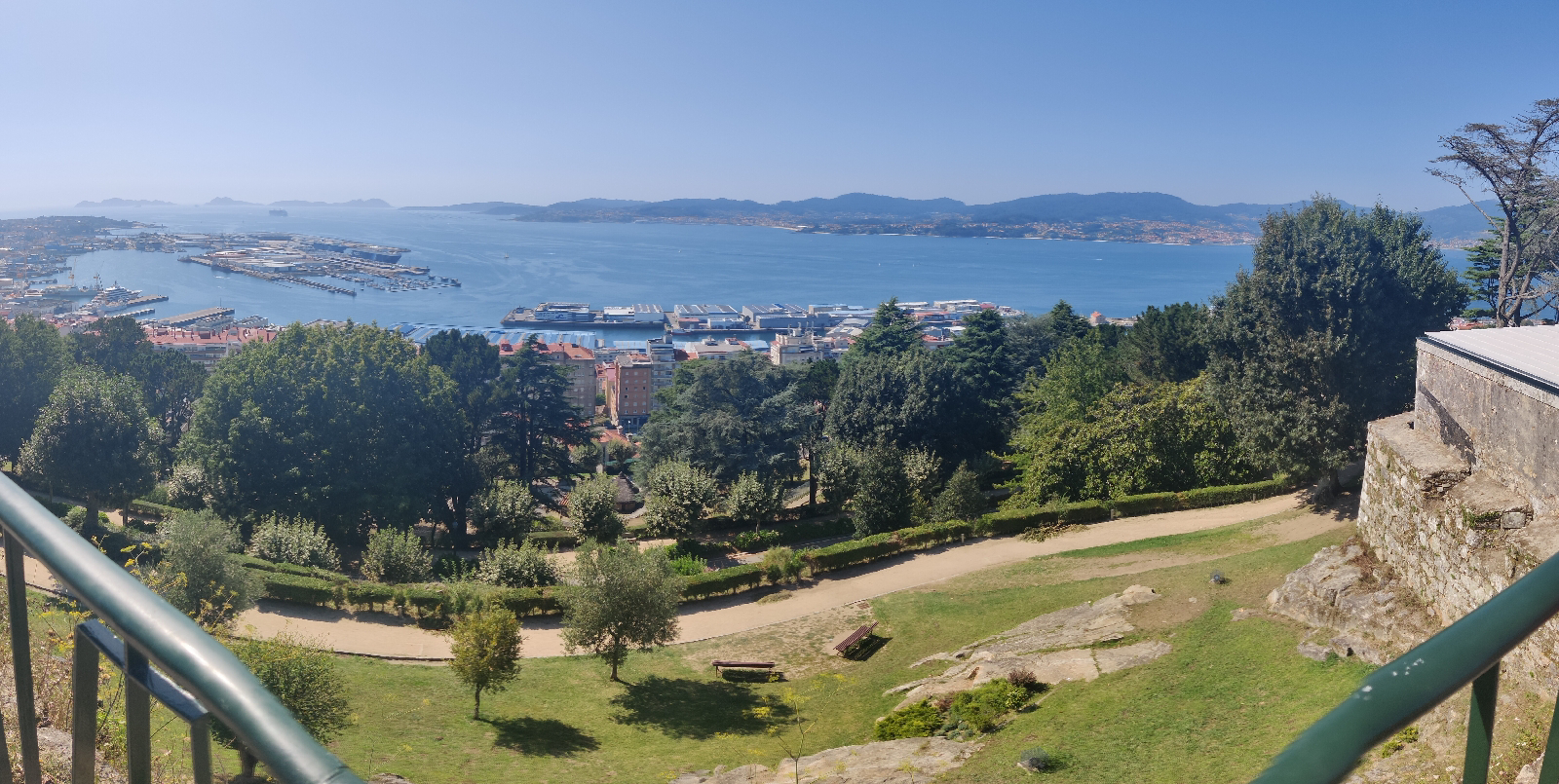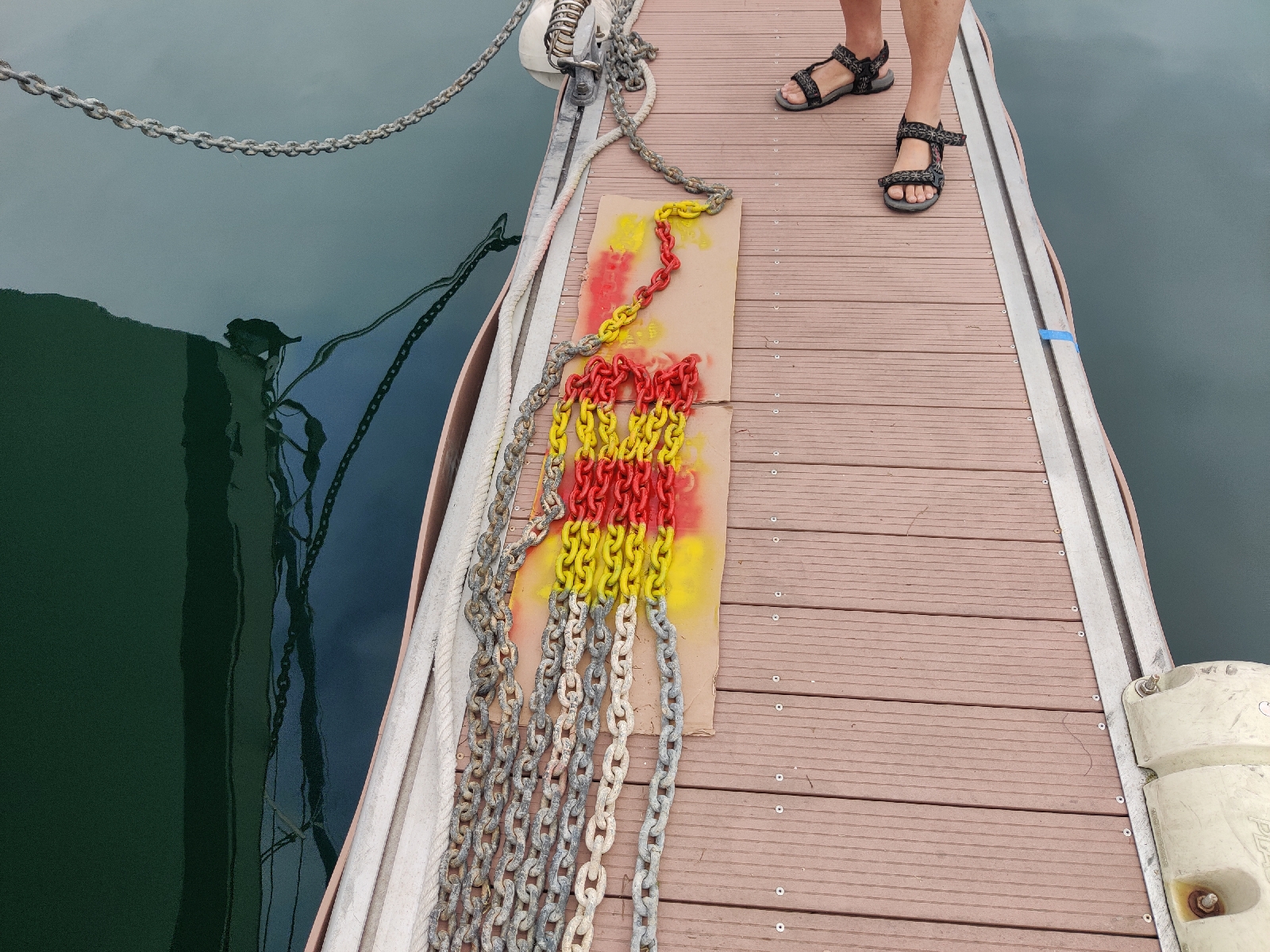We arrived in Bouzas, Vigo around 2015 local time on Monday 7th August and moored up in the local Marina berth that Alberto, OCC Port Officer had very kindly arranged for us. The following morning Alberto arrived with Lolo from the local metal workshop to inspect the Hydrovane, following which Lolo pronounced "no problem" and took it off promissing we would to have it back the next day. See the Hydrovane posts for the details.
Once Alberto and Lolo had gone we booked into the Marina.
The staff there were delightful and went out of their way to tell us about the local area, and Vigo itself about an hours walk from Bouzas. Neither of the two ladies could speak much English (and our Spanish is not up to much though Mick's is better than mine) but they used Google Translate very effectively to tell us all we needed to know. They described the yacht club as a "sailing high school" and it certainly had lots of youngsters on the water in dinghies and canoes as well as using its land based facilities including a Gym and showers which were excellent and which we made good use of.
They described Bouzas as a fishing village which rather undersold what was the busiest ship building and repair port (of small to medium sized vessels) we had ever seen. There must have been nearly a dozen working yards squeezed cheek by jowel along the water front that we nicknamed "Shipyard Alley".
Word had clearly got out about the local ship building facilities and capabilities because one of the yards had just completed the constrction of what - thanks to one of Mick's pals - we learnt was apparently one of the largest private motor yacht to be constructed in Europe in recent years. "Reinasance" was being fitted out and was soon to be available for charter....
We discussed why anyone would go to the clearly very considerable expense of buying such a huge craft. Clearly it's much too big for simply enjoying a day out on the water or even for taking the biggest family cruise, even if that included all of one's mates too. We concluded that whilst chartering and tax dodges no doubt figured in the 'owner's' calculations, the main reason for the commissioning of such an opulent craft, must be to 'make friends and influence people'. The 'friends' and 'people' in question no doubt include many of the richest and most influential shady characters on the planet. Of course that begs the question - if you've already got the kind of money needed to fund such an enterprise, why on earth would you need to influence any one else about anyhing? Oh, perhaps it's for hosting international gatherings aimed at saving the planet? Hmm, not a solar panel or wind genertor in sight, so perhaps not. Anyway at least its construction contributed to the local Bouzas economy and created some additional local jobs.
The locals on the other hand are clearly mindful of such issues - on our way into port on the Monday evening we passed a very large duel fuel - battery and LPG - commercial ship.
Bonny's berth was just yards from the water frontage of one of the many yards.
It also seemed that the fishing industry was still in pretty good health here. Apart from the various fishing boats clearly in commisson and being worked on in the yards there were two very large fish warehouses near the marina. Indeed we had to walk past them to get to Bonny's second berth - allocated to us by the ever helpful and friendly President of the yacht club/sailing school so that we could back Bonny onto a pontoon, thereby providing us with a work platform for reinstalling the Hydrovane. For some bizare reason the first time we walked down 'Fishyard Alley' I didn't notice the aroma and asked Alberto what the large building to our left was used for. He gave me a slightly amused look and said "fish". The smell was certainly quite noticeable on all our subsequent walks past.
You might think a marina sandwiched between a working ship yard on one side and fish warehouses on its two other flanks would not be a particularly attractive place. Indeed, Mick commented that it "must be the most unappealing marina I have ever seen". However, I found it had a unique charm and appeal of its own. The adjacent shipyard with its ever moving huge hoist and crane, its persistant daytime banging, booming and clattering and its industrial, night time beauty....
.....and most of all, the extremely friendly, warm and generous local people, creates an eclectic and most pleasing atmosphere. The preponderance of fairly modest craft, the well populated marina bar and the near constant activity at the club/marina/sailing school, including its use by lots of young people, encouraged this general feeling of wellbeing one had when in and around the marina.
I also thought I spied a familiar shape in the middle of the marina. I'd first noticed the ketch with brown sails as we sailed up the Ria on our approach to Bouzas and here she was again and so I had the opportunity to investigate. Sure enough, I had stumbled across one of Arctic Smoke's relations - another Elizabethan 33!
I'd not come across a ketch (two masted) version before and was surprised to come across an example of this limited run of British designed (and most probably, built) boat in a marina in Spain.
Looking at her made me realise how narrow the Elizabethan 33 is compared with the Biscay 36...
Of course there was a sizable fishing fleet too and no doubt a number of the yards served it, but there were also all sorts of other vessels in the various stocks, slipways, docks, and sheds strewn around the Bouzas water front.
We found some examplesof the local catch in the local market..
Significant evidence of the old fishing village remained with old buildings and cobbled streets and much of it was host to a plethora of reasonably priced restaurants and bars - which were doing extremely good business. Some appeared to be family concerns and others run by young entreaupenere types. A few were clearly up-market. Of course we were duty bound to sample the more economic ones during our stay. We got generous meals with a couple of rounds of beer and/or wine for around 20-25 Euros per head. Once again, all the staff we came into contact with were absolutely charming and helpful - doing their very best to help translate their menus for us. Another remarkable feature of the eating out pasttime here, as in Gijon, was the complete absence of tipping. When we tried to leave a tip it was politely refused!
Once we had completed the our check in at the Marina we set off on foot to explore Vigo. Our route took us the entire length of 'Shipyard Alley's' two or so miles which started just round the corner from the marina and ended at the cruise ship terminal on Vigo's water front. In addition to the shipyards on the waterfront side of the 'Alley' all sorts of related industrial, commercial, administrative concerns, including a college, lined the other side of the 'Alley'. Just past the cruise ship terminal was Vigo's main marina - "Real Club Nautico" where Tony and I parked Arctic Smoke in 2015 also on our way to Madeira. Being in pre-Orca days though we then had the luxury of also visiting Lisbon. Indeed, on that occasion we visited Lisbon twice. Once by train from Vigo to link up with Sharon and Sue and again a few weeks later in Arctic Smoke. This time, however, Brexit and the Orcas have combined to make a similar itinery impossible. Brexit means we have a time limit of 90 days within the common Schegen area and the uppity Orcas make passage making down the Portugese coast a riskier than 'normal' undertaking.
Indeed, we have already fallen victim to the complications arising from our non-EU status. We completely forgot about the 'need' to formally check out with the immigration authorities at Vigo. Had we done so, our estimated 5-6 days at sea between Vigo and Madeira would not have counted towards our 90 days limit. This over-sight may well complicate things for me later in the European section of the passage because I will be very close to that limit. Assuming we check out of Madeira properly and that we spend 3 days at sea before checking in in the Canaries, we'll either need to leave the Canaries by 1st November or I'll have to leave the Schegen area temporarilly for an appropriate period. Mick doesn't have the same problem because he has already arranged to return home for six weeks or so during September and October to attend to a variety of matters. So I may either need to find somewhere safe and cheap to leave the boat for a couple of weeks and fly home, or take the boat out of Shegen. The nearest and obvious place would be Morocco. The former would be preferable subject to the costs and then I could see the family. The complication is finding that safe cheap place to leave the boat. The main marina in the canaries is at Las Palmas, Gran Canaria and is very good value but the ARC - Atlantic Rally for Cruisers - has all the visitors berths booked out, I think from late September to mid November so I'm not sure whether that will work for me.
Anyway it was pleasantly nostalgic to retrace some old steps made with another ship mate. I remember scratching my head the first time Tony and I saw this poor fellow near the Marina...
After a wander around the marina area Mick and I set off uphill towards the main town centre. However, it wasn't too long before we felt in need of sustenance and refreshment and so headed up a promissing looking street leading from the area around the cruise ship terminal towards the town. As we walked up the street the occasionl local bars and cafes morphed into densley packed and increasingly trendy restaurants. These were all packed withcustomers and so we retreated back down the hill where it looked like we had a better chance of finding a table. We did and at what tuned out to be an excellent Mexican Oyster restaurant which would not have been out of place amongst the trendy restaurants. We didn't realize it was an Oyster place until after we had sat down but luckily given that neirther of us are big Oyster fans, they served other seafoods too. We had roasted prawns in a delicious sweet sauce and a roasted cheese dish served with wraps.
Both were absolutely delicious and with a beer and the ubiquitus cheescake and coffee (for me) for desert provbided an ample lunch. The proprieter was clearly a little surprised we did not eat more however. He was a charmig chap who had emigrated from Mexico a few years previously and set up the business here. Perhaps returning to family roots? It turned out he was familar with some of New Mexico too that Mick had visted during his time in the USA back in the 1980s.
After lunch we continued on our way into the town centre where we encountered another example of the Spanish prediliction for dramatic street art...
The ladies at the Marina had recommended that we climbed the hill above the town to enjoy the stunning views over the Ria and so we continued upwards to do just that. The hill is topped with old defence embankments similar to those found above many British ports.
It was quite a climb to the top but it was worth the effort because the views were in deed quite stunning...
After taking it all in we headed back down via a different route and encountered another example of dramatic street Art...
It was a pretty warm day and we had neglected to take any water with us so the priority on the return leg was to find the nearest bar for a refreshing beer. Thankfully we did not have to walk to far to find one.
After leaving the bar we came across this rather remarkable tree. It's trunk had been almost completely hollowed out, presumably by some sort of disease but it was still flourishing as you can see. Another feature which I did not notice at the time of studying it in the flesh as it were, was the addition of painted marks on its trunk which gives the appearance of a rather charming face....
Approaching Bouzas we came cross the biggest Lidl store I had ever seen and stopped off to top up the boat's dwindling supply of beer.
[insert Liddl photo]
The very next day as promissed,Tuesday, Alberto and Lolo retuned with the repaired Hydrovane and what an excellent job Lolo had made of it. Lolo only charged 180 Euros which for me was the bargain of the century - see my seperate post on this topic for more details.
Thursday and Friday we spent working our way through the ever growing list of jobs that comes with sailing an old boat on long distance ocean passages.
In this connection, my thanks go to one of Mick's old pals John, whom I have never met but is following the blog and who, being an educated chap mentioned to Mick that it reminded him of "a philosophical conumdrum, posed by the ancient Greeks, called 'The Ship of Theseus'. Theseus and his crew embark on an epic voyage and over the course of some years, every part of the ship is replaced, but at different times. So is the ship that returns home the same one that departed?..."
The first of two major jobs of the couple of days concerned the ancient Rutland wind generator. Mick had previously worked out that in order to get an significant benefit from it it needed a new regulator, the current (pun not intended) one being designed to keep a lead acid battery topped up, 'sees' our starter battery as always full, because, thanks to our solar panels always is, and therfore never allows any significant current into our battery bank containing in addition, two 100 Amp hour Lihium batteries. But, not only was it not contributing anything it was also undermining the effectiveness of our solar pannels by casting a rathe large shadow over the main top panel whenever the sun was shining from the port side of the boat. It would be doing this a lot on our passage south and west and with all the added consumption devices we had installed - mainly the water maker and water heater and the new fridge, we couldn't affort to waste an Amp. A new regulator could not be aquired locally quickly (although the excellent local Chandlery coud have ordred one for us) and so we decided to remove the wind generator. This seemed to make a significant difference and will hopefully provide just enough power for all our needs.
The second concerned the anchor chain. It's not that there was anything wrong with the chain itself but the cable ties we had been using as rather ineffective markers of the length of chain deployed, had started to break off leaving what was now a completely random sequence of cable ties along the chain that bore very little resembelence to the series of markings we had originally fitted. It was therefore becoming increasingly difficult to work out how much anchor chain we had let out. The Mate suggested a paint job was therefore required and devised the following colour code to show all would-be anchor hands, how much of our 50 metres of chain they had allowed to slip through their fingers...
10 Metres = Yellow Red Yellow
20 Metres = Yellow Red Yellow Red Yellow
30 Metres = Yellow Red Yellow Red Yellow Red Yellow
40 Metres = Yellow Red Yellow Red Yellow Red Yellow Red Yellow
45 Metres = wait for it ...... Red Red Red Red Red Red Red Red Red Red - actually one continuous band of red.
Some may think the amount or red at 45 metres a trifle over the top BUT there is a very good reason for the apparent excess.
The perenial anchor chain is the source of the expression "the bitter end". That's the end that's made fast to the boat! But in order to avoid accidently pulling the front of the boat off in the event of all the chain running out with 50 llbs of anchor on the end (which would create a rather large yank) , the 'bitter end' is made fast with a relatively light piece of rope, that would in such circumstaces, break. The boat would be saved, but it would be the bitter end for the anchor and its chain!
I'm not entirely sure why it's "bitter" however. If I was writing this with access to the internet I'd look it up, but I'm doing so whilst we're enroute from Vigo to Madeira. My guess is that it's connected to the term "bight". A "bight" of rope - and originally anchors would have been deployed on rope not chain - is a section or loop of rope and so perhaps the "bight" or "bitter" end distinguishes the end made fast to the boat as apposed to the end on the anchor!
Our last day in Bouzas was Saturday. We got up early (for us) at 0800 and went out to shop for provisions. The last job before leaving the Marina was to fit the Hydrovane rudder. This required getting in the water and so I donned a wet suit before getting in. The water was quite warm but I was glad of the wet suit because I wasn't sure how long the operation was going to take. It turned out that instaling the rudder was quick and easy and I was back out within a couple of minutes.
On leaving the marina we fueled up and headed down the Ria and out to the open sea bound, we hoped for Porto Santo, Madeira.






























No comments:
Post a Comment